CONNECTIONS
I remember
sitting in that miserable
1950-style lecture hall
on an early summer’s
afternoon when suddenly
what came up on the
screen caused me to bolt
upright. The members of
the class were happy as
we were coming to the end
of our pre-clinical years
and would soon be leaving
that lecture hall where
we had sat and suffered
through biochemistry and
physiology and other
equally difficult
subjects during the past
two years and would soon
be going to the wards!
What I saw
on the screen brought me
back to reality with a
bang. I was sitting in
one of those
uncomfortable wooden
seats with their little
fold-up tables on the
right side and
half-listening,
half-sleeping while
someone standing at the
front was attempting to
interest us in a variety
of bacterial diseases.
Unfortunately, the slides
used to illustrate the
salient features of the
diseases were old and
discoloured, which made
it difficult to actually
see them. Most of my
classmates had given up
trying to see them and
had nodded off. It was
beyond me why the school
had not updated their
teaching aids by now.
Surely they could afford
to do so. Couldn’t
they take a few pennies
of the tuition money paid
by the 115 people sitting
in the class and buy new
materials instead of
bringing out these
miserable slides each
year?
In spite
of the poor quality of
the slide, I saw
something on the screen
that was a revelation!
There, in that loathsome
uncomfortable lecture
hall, on that hot early
summer afternoon, was the
answer to something that
had been puzzling me for
years, in fact to my
second year in infant
school to be precise.
Without meaning to, like
Archimedes when he leapt
from the bath, the joy
that I was feeling inside
suddenly found its voice
and came bursting out of
my mouth before I could
stop it. My declaration
was loud and woke up my
class and so flustered
the lecturer that the
poor thing froze. Feeling
that perhaps an
explanation was in order,
I decided to share the
cause of my disturbance
with my class. I stood up
and began to tell them
about my early schooling
and of a classmate of
mine. While I was doing
this, I was also reminded
of a relative of his and
how he had been
instrumental in sowing
a seed in my mind,
which lay dormant for
years, but which
eventually germinated and
bloomed into an interest
that bordered on an
obsession. Imagine all
this from meeting two
small schoolboys. As we
say in the East End
…… go
figure!
.
AN
AMERICAN IN LONDON
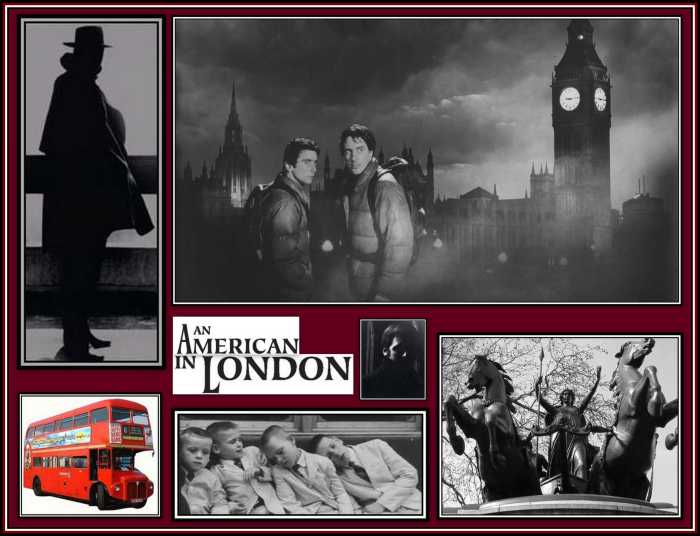
Click on
the pictures for songs of
London
Within
a split second, I was
back in Miss Davis’
class at Sir John Cass
Foundation School in the
City of London and
sitting at that little
desk in another
uncomfortable wooden
seat. Normally, a child
such as I would not go
this school as I lived
outside its catchment
area.me. My mother
made it clear to my
father However my mother
somehow managed to
persuade the school
authorities to accept and
me that she did not want
me going to school in the
East End. It wasn’t
that she was a snob,
because she wasn’t,
but she knew that were I
to go to school there, my
chances of getting a
completely honest, I
never understood scholarship
would be nil. To
be what this infamous
scholarship was and I
doubt if my mother knew
either. However, what she
did know was that it was
something vital to
getting a good education.
And she knew that without
one, you did not go to a
good school where you
could get a good
education. And without a
decent education, my
mother was convinced that
you were limited in
life’s choices. She
believed that you would
be doomed to work in a
factory, or at the docks,
or worse yet, doomed to a
life of crime. No, my
mother was not going to
have those kinds of
choices for her son. No,
I was going to get my
chance to escape the
typical East End life and
she was determined to do
what had to be done to
see to it. And obviously
she did, for I went to
Sir John Cass Foundation
School.
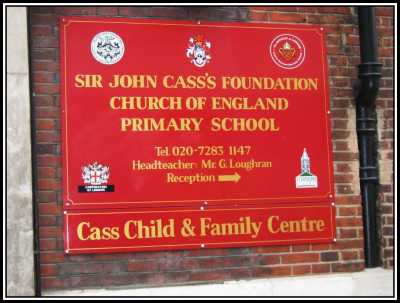
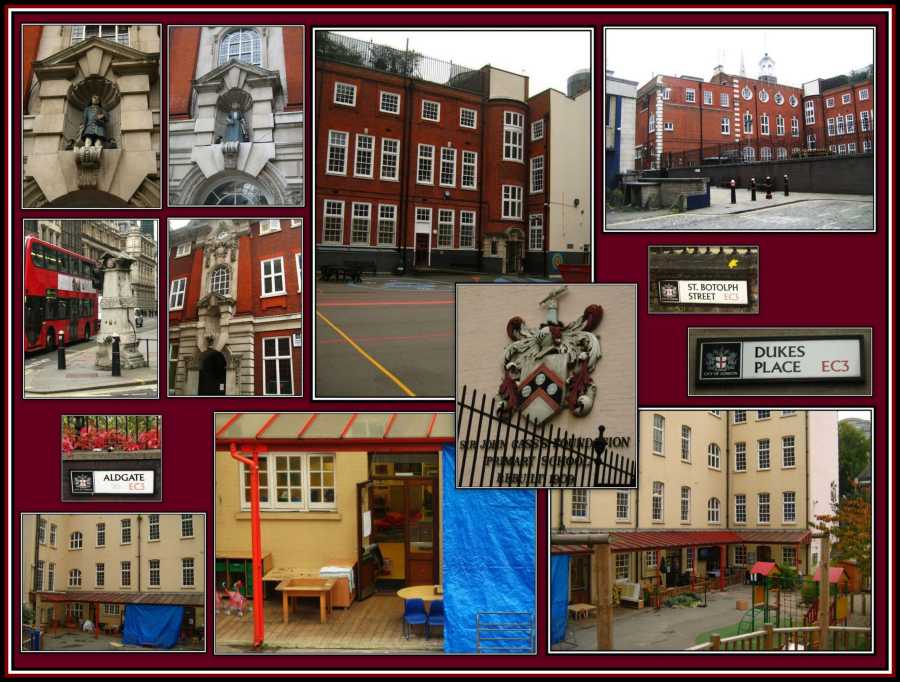
I remember
that it was just before
Christmas and we were
making paper decorations
to put on the walls of
our class. Some class
members were being
allowed to use scissors
while others were not. I
can’t remember by
what criteria Miss Davis
used to decide which
child used scissors and
which ones did not. The
chosen ones were making
various cuts on folded
paper, which when
unfolded revealed a
repeated pattern of holes
shaped like diamonds,
circles and squares.
Those deemed unsuitable
to wield the scissors
were told to paint the
decorations in bright
colours. We were allowed
to choose our own
colours. Once the paper
chain was suitably
decorated, it was left to
dry and we were told that
later in the day they
were to be pinned on the
wall thereby giving the
place that Christmas look.
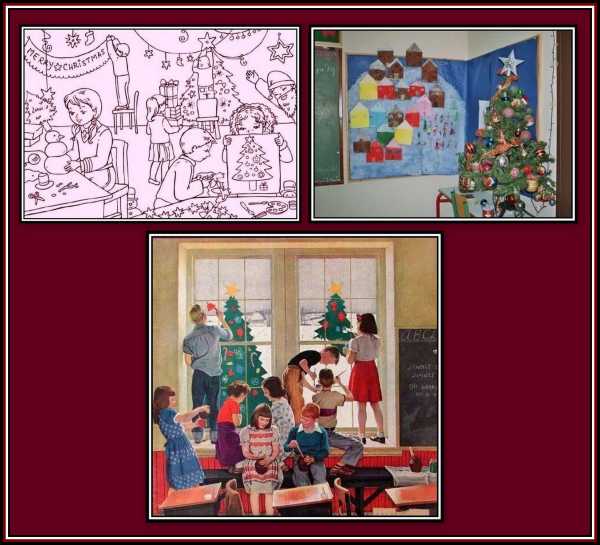
Click on
the picture for music
I was
sitting at a tiny table
that were normally stored
around the perimeter of
the classroom and only
used for painting
which, considering we
young artists, was
a stretch of the
imagination. There I was,
sitting there quietly and
dolloping paint onto
someone’s freshly
made paper chain and
trying to do a good job.
I suspect that the reason
why I was doomed to paint
was because I was one of
the youngest in the class
and obviously considered not
yet ready to be
trusted to climb the
mountain of advancement
and rest among the giddy
heights of scissor use.
While I busied myself
with my art, the
classroom door opened and
one of my classmates,
James Joffery came in and
was accompanied by the
most curious looking
fellow I had ever seen
off a cinema screen.
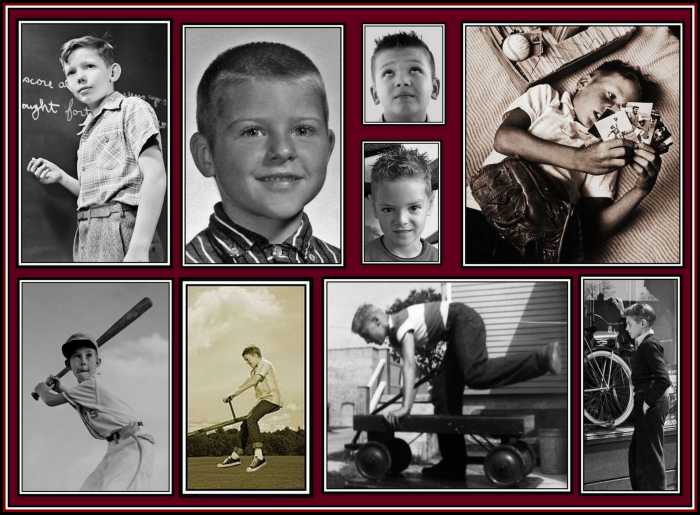
Years
later, while reading Oliver
Twist, I was reminded
of this little boy when I
came to Dickens' description
of The Artful Dodger.
Although this kid was
perhaps not as flamboyant
as Dodger, he was
nonetheless a figure
of curiosity, like
someone one might expect
to find after tumbling
down a rabbit hole while
chasing a white rabbit on
a lazy summer’s
afternoon!
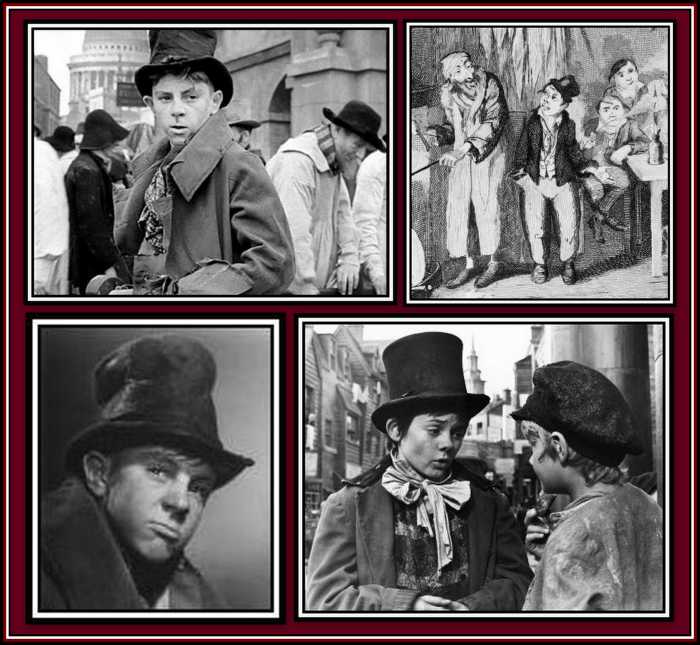
Click on
an Artful Dodger to view
a clip
Although
this curious looking
fellow was obviously a
boy, he did not have the
appearance of any boy I
had seen up until then.
And if his appearance did
not instil interest, his
walk or rather his
mode of locomotion certainly
did, for it was like none
other seen. He sauntered
into the classroom
with a definite swagger
that caused him to
twist from side to side
as he lazily dragged his
feet lazily across the
floor like some cowboy moseying
up to the bar of a
saloon. His manner of
entering the classroom
and his way of tackling
the space between the
door and Miss Davis’
desk was with the energy
of someone not especially
fussed whether they got
to their destination or
not. His apparent disinterestedness
in where he was being
led was compounded by the
vacant look on his face.
His movement seemed
excessively deliberate,
like a lizard moving
across the sands of a
desert. He gave me the
impression that the mere
act of walking or
thinking about it
exhausted him. He seemed
to slow down as he
continued on his way so
much so that I half
expected him to stop in
mid-travel and yawn and
stretch and perhaps
remain still for a minute
or so to rest a while
following this obvious
excessive display of
energy. Again, years
later, I thought of this
boy when I met a woman
where I was working. She
was a delightful person
and I became very fond of
her, but it exhausted me
to walk with her for she
moved with the speed of
old glass in a window
pane. I remember getting
out of the lift with her
when going to her
apartment for the first
time. I was immediately
struck by the fact that
she seemed to walk slower
and slower the nearer she
got to her door and came
to a virtual stop two or
three steps from
journey’s end. It
was if she had somehow
taken her bones out and
had to flow the
last few steps of the
way! Once inside, I
collapsed from
exhaustion! Once at his
journey’s end, the
boy remained in place,
vacantly staring slightly
above our heads.
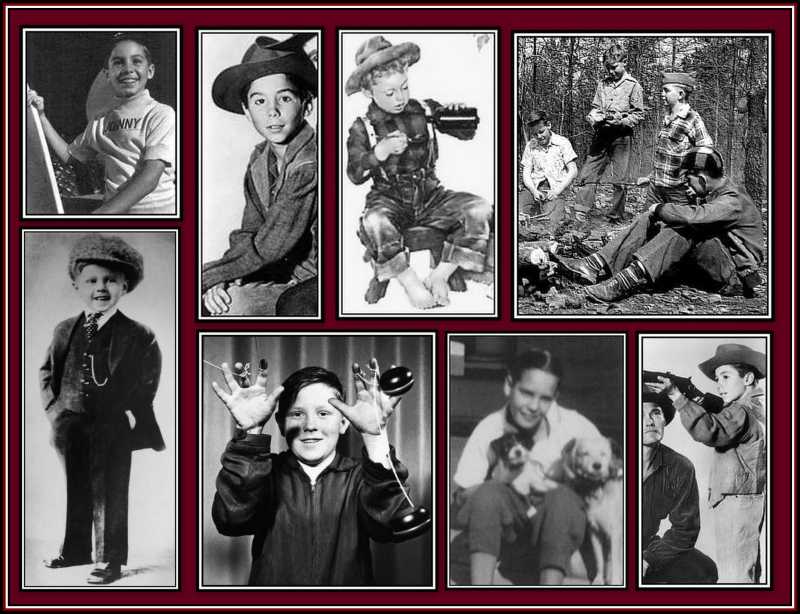
Unlike his
companion, James looked a
little flustered as he
mumbled something to Miss
Davis. James was not a
kid to seek the limelight
and preferred to go
about his business
quietly and unnoticed.
Miss Davis nodded in
response to whatever it
was that James told her
and then called for
silence. Her request was
totally unnecessary since
the mere presence of this
boy was enough to silence
us. It was as if we had
been frozen in time with
our brushes dripping
paint and our scissors
poised in mid-cut. Once
our composure had been
regained, brushes and
scissors were put down
and Miss Davis turned to
this strange looking kid
and introduced him to us.
Miss Davis
was a sweet woman, who
was probably in her
mid-thirties at the time.
She was very shy and reddened
whenever she had to
do something out of the
ordinary. Introducing
this boy proved to be
such an occasion for her.
We noted the redness
creeping up her neck and
across her face and then
up to the roots of her
fair hair when she began
to speak. We liked her
very much, as she was
very kind to us and was
very encouraging and
never shouted like so
many teachers that were
to follow her. She lived
at Leigh-on-Sea with her
mother and took the train
to Fenchurch Street
Station each day and then
walked the mile or so to
school. I often wondered
what happened to her and
if she ever married. She
was a charming woman and
I hope that she was
happy, whatever she chose
to do.
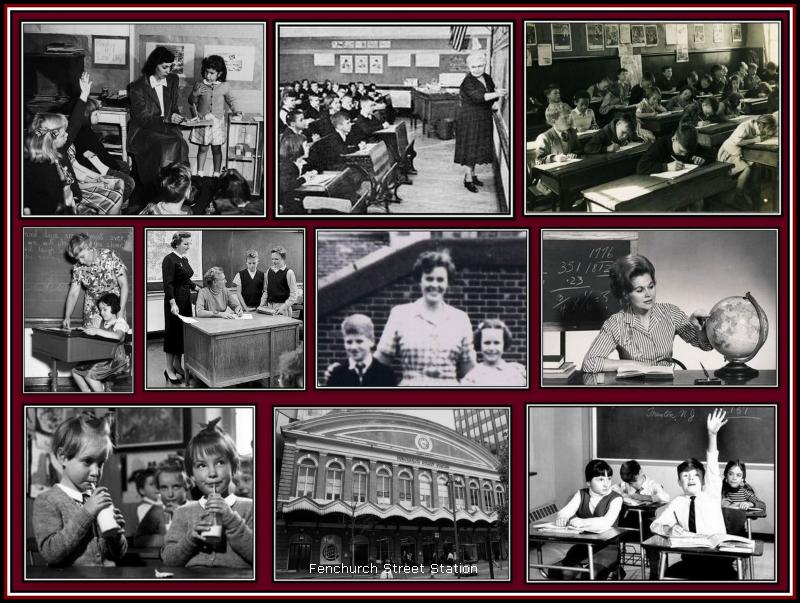
The
now-very-red Miss Davis
told us that this curious
fellow who was visibly
wilting now had travelled
a long way to be with us.
I remember thinking that
this must be the reason
why he appeared so tired.
I also remember thinking
that her introduction
made him sound like some guest
star on a radio
programme! And now
ladies and gentlemen,
boys and girls, for your
special delight and
entertainment today, we
present to you
……!
We learned
that the boy was an American
and came from the United
States. This
immediately confused me
since I came from England
and was English
and my friend Mohammed
came from Pakistan
and was Pakistani
or as I should say, an Englishman
of Pakistani decent.
So how come he was American
if he came from the United
States? When I asked
Miss Davis about this
obvious confusion, she
reddened once more and
gave me no explanation
and just glared at me and
moved on to talk more
about this fellow. I had
to wait sometime before I
received a suitable
answer to this question
and all became clear.
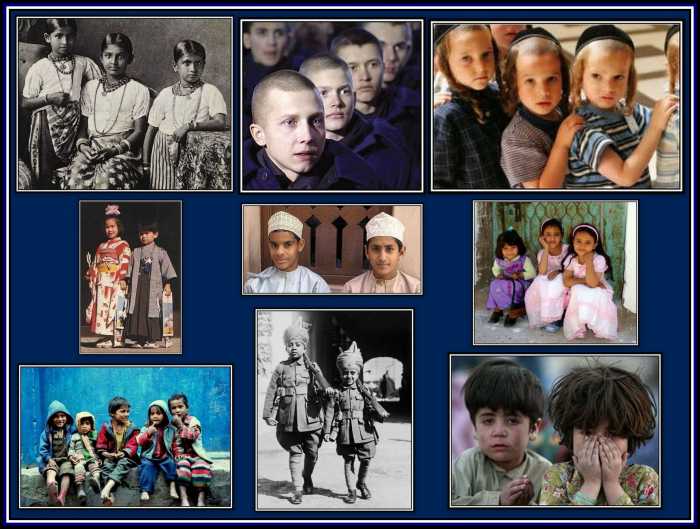
In this
day and age, the world
is, so I have been told,
a smaller place than it
once was. This means, I
presume, that since
travel is more accessible
and cheaper, more people
have ventured forth to
other lands. Supposedly,
we have now been exposed
to different peoples and cultures.
However, in the early
1950s, few travelled to
other lands, and those
who were able to, were
either more well to do
or else in the army, as
most folks did not have
the money for such jolly
jaunts. Since I lived in
the East End, I had
always been surrounded by
folks born in other
countries with different
religions and cultures.
My part of the East End
was a place where
immigrants generally
settled first when
entering Britain. My
class consisted of about
40 children. Of the 40,
most were Jews, both born
in England and in Europe,
together with others from
India, Pakistan and
Ceylon along with a
couple from African
countries. People like me
were in the minority.
However, to us, everyone
was the same since
everyone spoke in a
similar manner and we all
dressed in the same style
and all the boys had the
same type of haircut
except for those that
wore turbans.
Just one
look at that curious
looking fellow who now slouched
before us was sufficient
to tell us that he was
obviously not a local
boy. He was a little
taller than the boys in
my class and was quite
lanky. It turned out that
he was a year older that
most of the class.
However, almost
everything about his
appearance was different
from what we were used
to. We might have as
easily believed that he
came from Mars had we not
been told that he came
from the United States
and was an American.
Mind you, for all we
knew at the time, the United
States might well
have been a place on
Mars!
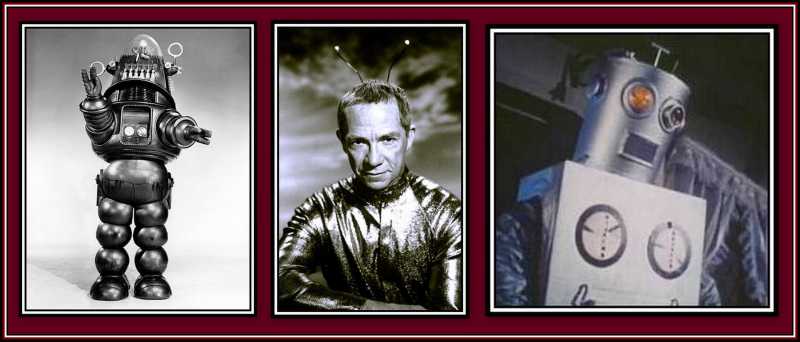
One of the
most noticeable features
of this boy was his hair.
What there was of it was
fair. But it had
obviously not been cut by
an East End barber! It
was cut in what I later
learned to be a crew
cut. I had never seen
such a cut before. It
looked like nothing I had
seen in the pictures on
Maurie’s wall, my
father’s barber
where I was dragged to
periodically. The hair on
top of his head stuck
straight up in the air
and did not seem to move.
The rest of it, at the
back and at the sides,
was shaved and gave him a
bald look.
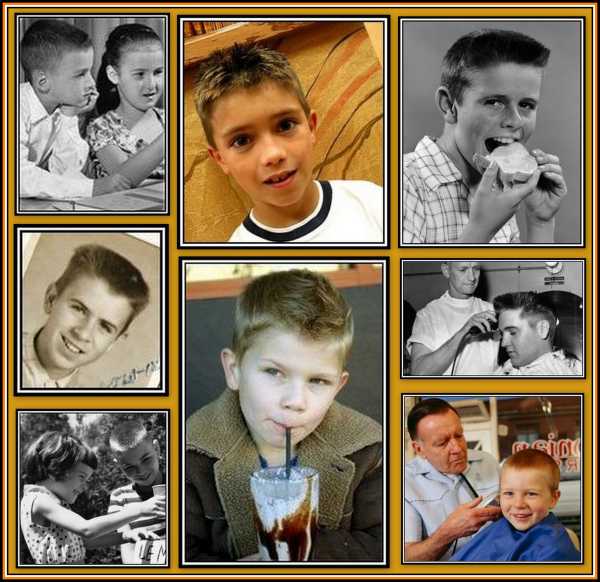
As if his
hair was not strange
enough, his clothes were
also different and
nothing like the current mode
worn by little boys
in post-war Britain!
However strange his
clothes were, their
colours were even
stranger and were totally
unknown to me. Firstly he
wore long trousers. In
those days, English boys
did not wear long
trousers until they were
about 12 or 13-years old.
They wore short trousers
together with long socks
that were kept in place
by elastic, which easily
broke causing the socks
to bunch up around the
ankles and thereby annoy
mothers to no end! His
trousers did not appear
to be made of cotton or
wool, but of some other
fibre also unknown to me
at the time. However, it
was their colour that
remains most vivid in my
memory. It was a light
reddish chocolate brown
colour. I remember this
well as I had never seen
such a colour before.
Although sweets and
chocolate were still on
ration at that time and
were not easily
accessible to kids, I
knew what chocolate brown
looked like from both dark
and milk chocolate. And
I knew red, but this
shade of reddish
chocolate brown was
totally new to me and not
especially agreeable to
my eye. I remember that
his trousers had turn-ups.
Although turn-ups were
normal at that time, what
made them noticeable was
that they were on
trousers worn by a child.
This addition to the
garment made him look
like a little old man,
as my mother would say,
which means that he was
dressed in a style, by
our standards, which was
too old for his years.
If I was
surprised by the colour
and style of his
trousers, I was shocked
by the colour of his
shirt! It was of a light
pink a colour, I hasten
to add, that boys did not
wear at that time. And as
equally shocking was the
fact that he wore no tie.
Ties were de rigueur at
that time for school
boys. One final thing
about his shirt: it had a
pocket on the left side.
I had never seen this
before. Clipped to the
pocket was a pen, but
more of that later.

Click on
the pink shirt and white
T-shirt for music
Also
noticeable was his
footwear. Or should I say
his footwear and foot
coverings. As the
turn-ups of his trousers
did not quite reach the
top of his shoes, we
could readily see his
socks. What was
remarkable about them was
that they were white. I
had never seen a boy
wearing white socks
before. I remember again
years later when I was
visiting a friend at the
University of Reading,
she introduced me to her
boy friend, who happened
to be an American. By
then one saw Americans
running around London and
one was used to their
mode of dress. Most
looked like that young
boy and all wore white
socks. Her boyfriend was
unlike most Americans
that I had seen in that
he was short ....... very
short. Most were
veritable giants. I had
been told that their
greater height and, so
they said, better health
than we poor Europeans,
was a result of the
healthier diet that
they ate. Apparently they
drank gallons of fresh
milk, ate bowls of cereal
and chewed on vast
quantities of meat. It
seemed that their
foods were filled
with every conceivable
vitamin known to man and
were meals were eaten so
as to provide a good
balance between proteins,
fats and carbohydrate.
Obviously, this poor
fellow must not have
eaten all of his dinner
as a child. Anyway, I
remember that we were
chatting and I said
something about the
Americans that I had met
and seen about the place
wore white socks. I said
that it was like a signature.
As I made my flippant
comment, my eyes moved
down to the boy
friend’s feet and
guess what? Yes, he too
fitted in with his
countrymen. For some
reason, I felt acute
embarrassment and hoped
for the floor to open up
and swallow me.
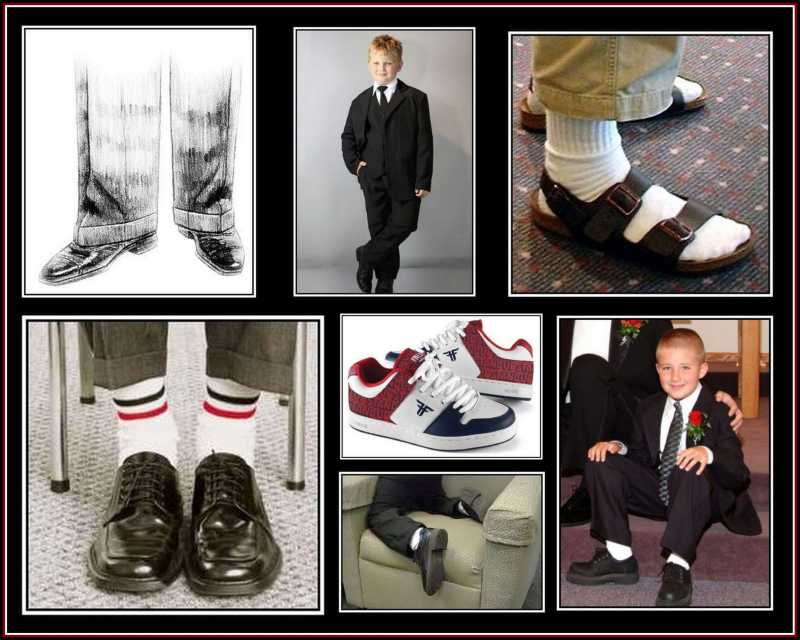
I now live
in America and find that
many people, men and
women, only wear white
socks. But then we live
at a time when the
casual look is in
fashion and people make
the effort to dress
down. In keeping with
the onslaught of American
Cultural Imperialism,
I observe, and sigh
deeply with regret, that
this mode has been
exported to Europe and
beyond and has been
received with much
success. Despite having
lived in America for over
thirty years, I have to
confess that I still can
not bring myself to wear
white socks, I am afraid.
To finish
my description of the
little boy’s dress,
I need to comment on his
shoewear. He wore white
shoes – or sneakers,
as I later learned they
were called. Until then,
I had never seen a man or
boy wearing white shoes
unless he was playing
tennis, that is. It needs
to be remembered that
this was a time before The
Jets and The
Sharks danced down
the street in T-shirts,
jeans and sneakers. The
wearing of sporting
apparel to school was
unheard of at that time.
Children wore shoes:
leather shoes, black or
brown, in winter and
perhaps sandals in
summer. When it rained
hard, Wellingtons might
be worn and black plimsolls
were the footwear of
choice when games were
played. One would never
think of wearing them for
general wear.
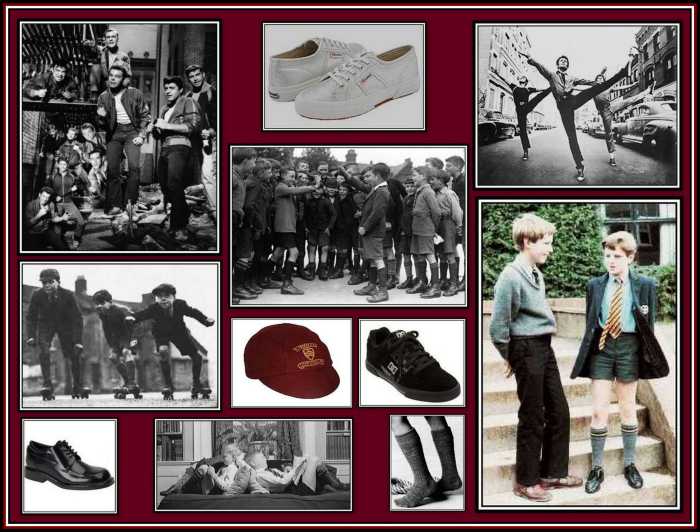
Miss Davis
told us that the young
boy was James’
cousin and told us to say
hello to Johnny,
as the boy was called. We
did as we were told in
unison. If I thought that
the kid clothes were
surprising and somewhat
different, I was in
for yet another surprise
once he opened his mouth
to speak. He answered our
greeting by saying Hiiiiiii
and making a slight
waving motion with his
right hand. His
lingering Hiiiiii surprised
me, his need to wave left
me totally confused. I
remember that the whole
class was silenced by his
greeting. We sat and
stared at this unknown
kid while he looked into
the space above our heads
with no expression on his
face at all. Evidently my
classmates were as
perplexed as I was
regarding who this
stranger was and no doubt
wondered which planet he
came from! He certainly
wasn’t like anyone
we had ever seen in
the flesh before.
Apparently,
Johnny was
visiting James and his
family and staying for
Christmas and the New
Year. We were told that
he was coming to school
for the last week of term
and would take part in
our Christmas
celebrations. Miss Davis
said that we should
welcome him and make him
feel at home. She then
turned to Johnny and
asked him where he was
from in the United States
and various other
questions about himself
and his school. Not even
Johnny’s look and
mode of dress prepared
us for what followed
next. Any remaining wind
in our sails was promptly
removed when he opened
his mouth to answer Miss
Davis’ questions! We
all sat there, frozen,
with mouths wide open
……. for Johnny
spoke English!
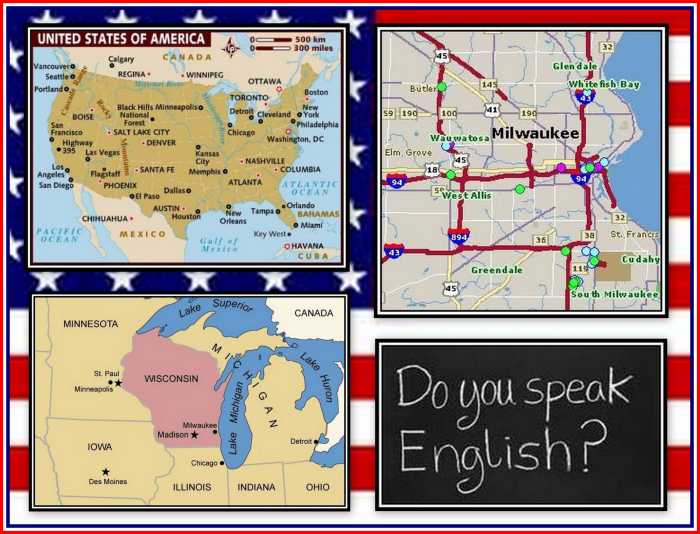
Today,
everyone knows where
America is, how an
American sounds and who
their President is plus a
whole host of other
things about the country.
When I was a child, we
saw American films and
heard the actors and
actresses talk. However,
at that time I did not
distinguish which film
was American and which
was English. They were
just films. I was still
at the stage when I
followed the action and
not the dialogue. I liked
sword fighting, Indians,
pirates and battle
scenes. Talking in a film
was something that
impeded the action and
was something to ignore.
Whenever the hero began
his wooing of the
heroine, it signalled the
time either to talk to
one’s friends or
else throw things at
others and create some
mayhem. Who in their
right minds actually
watched two people
kissing? I certainly
hadn’t thought about
the language that
Americans spoke and so
had absolutely no idea
that these peoples spoke
English!
Johnny,
being the little
old man that his
dress suggested, was
obviously not a shy
child, as he answered
each question posed by
Miss Davis without
hesitation and ended them
by addressing her as M’am!
Later, when we went
outside for playtime, some
of my classmates were
soon amusing themselves
by making up silly
rhymes: Do you have
any jam M’am? Have
you seen Sam, M’am?
And then the jokesters
burst into peels of
giggles, thinking
themselves very clever
and original.
There were
two empty seats at my
table and Miss Davis sent
this curious boy to sit
next to me while James
took the seat across from
us. I remember that once
Johnny sat down, he
turned to me, and without
smiling gave me another Hi!
Mercifully, this time he
omitted the wave!
James
normally sat next to me
in class since his name
appeared after mine in
the Register. Now it
seemed, Johnny would be
sitting there. As it
turned out, once I got
used to him, Johnny
proved to be a good kid
who was full of fun.
Without realising it,
thanks to Johnny, I began
to learn that people from
different places have far
more in common than you
think and that any
differences are of minor
importance. This has
since been proved to me
many times over.
Johnny was
about a year older than
us and was able to write
in ink! At our age at the
time, such a feat
represented a major step
forward in one’s
development and
education. Handwriting
was considered an
important part of the curriculum
in those days.
Teachers were strict and
insisted on good, neat
penmanship.
Mercifully, Ball Point
Pens and Biros were
still in their infancy at
this time. Sadly, my
class was still using
pencil. I also regret to
say that chalk and slate
were still employed for
doing our sums. I began
to look at Johnny
slightly differently now.

This now
brings me to the subject
of Johnny’s pen. It
should be remembered that
when I was a child, a
fountain pen was a highly
prized object and use and
ownership represented
passage from being a
baby to being more
grown up –
certainly not Grown
Up, but a sign that
one had successfully
taken one’s first
step towards the adult
world. Everyone in the
class was dreaming of the
time we had learned to
write in ink so that we
might receive our reward.
I could not wait for the
time when I could discuss
from first-hand
experience, the relative
merits and flaws of a Platinum
Fountain Pen and
compare them to the Conway
Stewart.
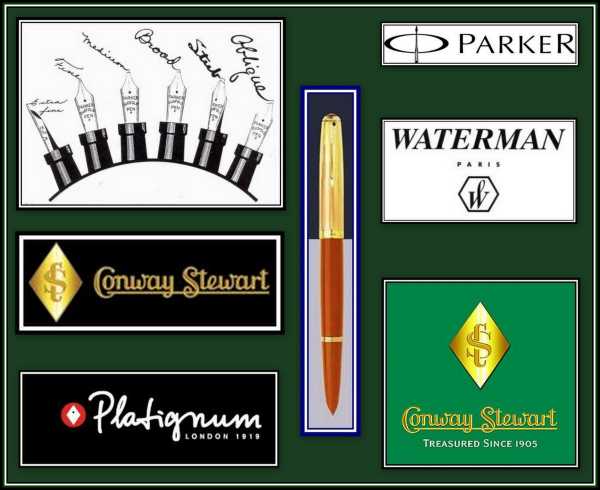
Johnny
owned a fountain pen,
which he proudly carried
in his shirt pocket for
all to see. His pen
looked like a space ship!
It was made of some
copper-coloured metal and
was decorated with a
number of fin-like
additions. Its clip was
in the form of an arrow
with a golden tip. I was
very impressed with its
look and asked to be
allowed to look at it.
Johnny obliged. As I held
it in my hand, I was
surprised by its weight.
I dared to ask if I might
write my name with it.
Johnny told me that he
was sorry, but he could
not allow me to use it.
He then went on to
explain why. He said that
only one person should
ever write with a
fountain pen, since
everyone presses on the
nib with a different
pressure and this
influences its stability
and affects your writing.
Naturally, I did not know
or care about nib
pressure, as all I
wanted was to write with
it! He could see that I
was disappointed and said
that he would let me use
his pencil sharpener, if
I liked? He brought it
out of his pocket. It was
a remarkable object, made
of plastic in the form of
a small aeroplane! I took
this magnificent object
and began to sharpen my
pencil even though it did
not need it. One could
not turn down such an
invitation. I was
becoming more impressed
with this kid by the
minute!

Sadly just
before we broke up
for the Christmas
holidays and we were to
say goodbye to Johnny, he
lost his pen. He was very
upset. Miss Davis was
also very upset and made
us scour the classroom in
the hope of finding it.
Wastepaper baskets were
upturned and the contents
thoroughly examined with
a fine toothcomb.
Cupboards and drawers
were emptied and
everything from them was
examined carefully. The
floor was looked over
once and then looked over
again. The whole
classroom was turned
upside down, but to no
avail. Although Johnny
was upset, he shrugged
his shoulders, and seemed
to accept its loss. He
told me that he hoped
that his father would get
him another one once they
went back home. I felt
very sorry for him.
However, any sadness was
soon pushed to the back
of our minds. It was soon
to be Christmas, the best
time of the year for a
child, and try as one
might, the excitement
generated by the coming
season soon overwhelmed
everything else. Besides,
we were soon to put on
our Christmas play and
later in the day we were
to feast on jellies and
cakes and then receive a
visit from Father
Christmas! With such fun
ahead, how could Johnny
not manage to cheer up?
Miss Davis
decided that we would not
put on the usual
Christmas play. This
would have been The
Story of Mary and Joseph
and the birth of Jesus. Last
Christmas, we presented
such a Nativity Play and
we had a good time
playing in it. Mary,
played by a little girl
that I liked and who had
the unfortunate name of
Patricia Weed, sat on
some wooden object
especially made by the
woodwork master from the
Senior School. He had
attached the frame to a
broom with stiff
bristles, which served as
the poor donkey’s
head. Mary and Joseph
pretended to go to
The Inn where the Innkeeper
told them that there
was no room. They
next pretended to
move on and eventually
arrived at a stable,
where they stopped and Jesus
was suddenly born and dropped
into a decorated wooden
orange box, provided by
the father of one of my
classmates, which served
as a manger. Jesus
was a doll that was
provided by one of the
richer girls in the
class, Ann Olson.
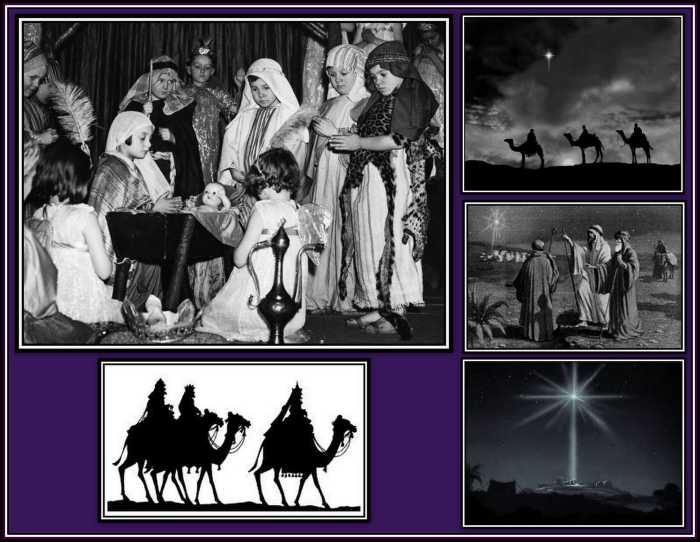
Click on
the individual pictures
to hear carols
At the
time I was not fond of
Ann Olson, as she liked
to pull my hair! Miss
Davis had told the boys
in the class that we were
never ever to hit
the girls no matter what
they did. She said
that we were to report
any bad action to her.
Right!!! Since we liked
Miss Davis, we tried hard
to do as she bade us.
Eventually one boy in the
class got so incensed by
having his hair pulled by
another girl that he
smacked her across the
face. This sent her flying
across the room! In
addition to being smacked
by Miss Davis, his
mother was asked to come
to the school to discuss
her son’s behaviour.
One should remember that
this was a time when
parents had little
interaction with school
teachers and their
child’s education
and punishment. After
seeing the shame
that his actions brought
on his mother and
himself, no one dared slap,
smack or bash a girl
and the girls in the
class took full advantage
of the situation for a
while. However, we
developed ways to get
our own back on them.
I remember once helping a
chum of mine tip some
paint in the lap of a
nasty girl that had been
bothering him.
| My
nemesis, Ann Olson had
long plaits with ribbons
tied at the ends. She was
a vain child and was
proud of her hairstyle.
During lunch, some days
she removed the ribbons,
but was never able to
replace them. When this
happened, she would find
me and pull my hair and
run to Miss Davis and say
that I had pulled her
plaits and made her
ribbons come free.
Regardless of what I
said, NO ONE, absolutely
NO ONE, especially
Ann’s mother
believed me. I remember
on one occasion that her
mother came up to me
after school while I was
walking with my mother.
She then began to scream
at me about how tired
she was that I was
pulling her
daughter’s plaits
and removing her ribbons.
I remember mother stopped
and turned to me and
asked if I had done this.
Now, I knew better than
ever lie to my mother
when asked a direct
question. I said that I
had never pulled her hair
or her ribbons and that
it was she who pulled my
hair. My mother and Mrs.
Olson then had a set
to, which led to Ann
not pulling my hair for a
while. |
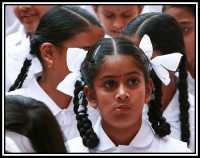 |
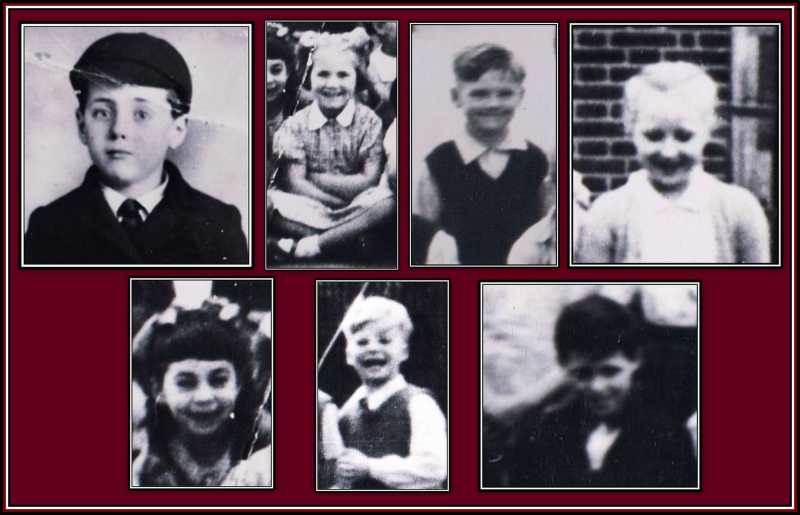
Top
Row: Me, Pat
Weed, Jeffrey Apen &
Ann Olson
Bottom
Row: Sandra
Alfred, James Joffery
& Me
Unfortunately,
Ann periodically pulled
my hair, which I
tolerated until our final
year at the school. At
that time, we boys noted
that the girls were
beginning to grow breasts
and Ann was showing that
she was to become a
well-endowed young lady.
I remember that one day
she pulled my hair in a
particularly violent
manner that brought tears
to my eyes. Enough was
enough! The camel's back
was broken! Suddenly Miss
Davis' words went right
out of the window and I
gave Ann a punch in her
newly developing breast!
I did not punch her hard.
It was meant to tell her
that I was not going to
tolerate her behaviour
any longer and that she
could tell her mother and
our teacher what I had
done, if she so chose! I
hoped that my tap would
be sufficient for her to
learn that I was not
going to tolerate her bullying
any longer! I was
amazed, as Ann did
nothing following my
response and quietly
walked away. The next day
Ann arrived at school and
from that moment on, she
was a different person
towards me. From then on
everyday she brought me
some sweets and began to
smile at me at every
opportunity. Even her
mother suddenly became
nice to me and even asked
me to come to their house
for tea. I went and we
shared a kiss while
sitting on their leather
settee. I was surprised
when she admitted to always
liking me! Go figure!
To return
to the previous
year’s Christmas
Play, most members of the
class squeezed on stage
dressed as the shepherds.
I played one of the Wise
Men. I enjoyed this,
as I had lines and
I believed that I brought
dignity to my role
while strutting around
in my robe and hat
very much in a manner
that I had seen in a film
set in Baghdad. However,
what I remember most of
this play was our special
back drop that we
made ourselves. At first,
it was fun to make, but
the task dragged on and
on and literally took
days to before it was
finally finished. Miss
Davis had given us lots
of cardboard sheets to
paint with various
colours, which when she
joined them together with
lots of sticky tape,
somehow, if one squinted
one’s eyes, looked
like the entrance to the
inn and also doubled,
perhaps unconvincingly,
as the stable. I remember
that I was not chosen to
be amongst those given
the supreme honour of
painting The Star that
the Wise Men were
to follow. I was somewhat
miffed, as I thought my
painting to be a cut
above most members of the
class! When I offered
my help, Miss Davis,
rather brutally I
thought, said that only
those members of the
class with the steadiest
hands were being
allowed to paint The
Star! I found this sleight
hard to forgive, but
perhaps since it was so
close to Christmas,
somehow I did.
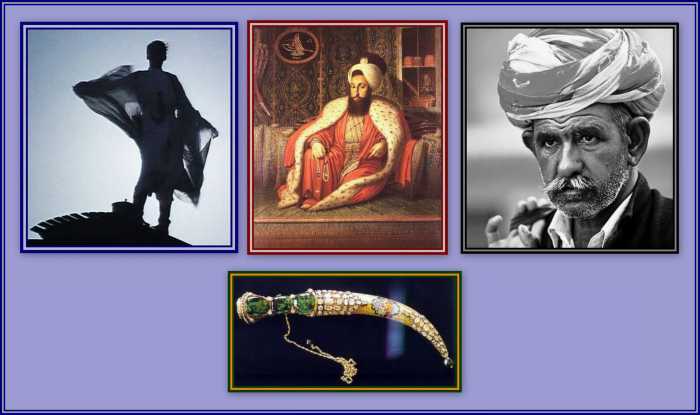
Click on Lawrence
of Arabia to hear
the Main Title from
the film; click on The
Sultan to hear
Rimsky Korsakov's Scheherazade;
click on The
Sultan's Dagger to
watch the introduction of
the film, Topaki; and
click on The Herdsman
to watch the film's
credits
For the
Christmas when Johnny
visited, Miss Davis
decided that we were not
going to present the
usual Nativity Play.
This was going to be left
to the other classes. We
were to present a Mummer
Play. Miss Davis said
that this was a play with
a long history and
traditionally presented
at Christmastide
in villages all over
England in ye olden
days. I remember that
this added excitement and
we were all in favour of
it.

For
information about
the history and
performance of the
Mummers Play, please
click on the link
here.
First
performance of Crook
Morris Mummers Play, 17th
January, 2009
Our play
was to be the final
presentation of the day
following those of the
other classes. I expect
that we dismissed these plays
as ordinaire and
totally forgettable,
since we were pretty full
of ourselves and were
no doubt expecting great
reviews. Although I tried
to watch the efforts
of others, I was far too
excited to concentrate
and wanted to get up on
the stage and get
going!
I really
liked our play, as the
cast of characters were
both interesting and
heroic and included St.
George, a dragon and
Father Christmas. What
more could one ask for?
With such characters, we
were guaranteed success!
After some auditions, I
was asked to play
Father Christmas.
Naturally, as far as I
was concerned, he was The
Star! I was really
looking forward to
playing the part and had
been rehearsing my lines
at home for days.
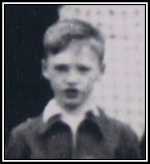 St.
George was being played
by some dopey kid who, in
my humble opinion, would
seem the least likely to
be heroic of all of us.
However, Miss Davis got
it right when it came to
the casting of The
Dragon. She chose the
boy, Geoffrey Apen, who
was the funniest kid I
knew at that time. It may
be difficult to believe,
but I swear this kid had timing
when he told a story
or a joke. He also had an
amusing face and it was
enough for me to just
look at him to start
laughing. He also had the
ability to squat down and
then run across the floor
at an amazing speed,
rather like a Cossack! We
were all amazed when he
would suddenly bend over
and dash off at top
speed. Miss Davis once
tried to have us all try
to copy this movement.
Most of us fell over
while a few moved slowly
and ungracefully across
the floor. Meanwhile
Geoffrey flew at top
speed between us. I used
to go over to his home
from time to time. He
lived on Anthony Street,
a street adjacent to the
Palaseum, just off the
Commercial Road in
Stepney. Each time I went
over, I was taken
downstairs to the
basement where I found
his family milling
around. I never did see a
room on the ground floor
of the house and began to
think that they lived underground. St.
George was being played
by some dopey kid who, in
my humble opinion, would
seem the least likely to
be heroic of all of us.
However, Miss Davis got
it right when it came to
the casting of The
Dragon. She chose the
boy, Geoffrey Apen, who
was the funniest kid I
knew at that time. It may
be difficult to believe,
but I swear this kid had timing
when he told a story
or a joke. He also had an
amusing face and it was
enough for me to just
look at him to start
laughing. He also had the
ability to squat down and
then run across the floor
at an amazing speed,
rather like a Cossack! We
were all amazed when he
would suddenly bend over
and dash off at top
speed. Miss Davis once
tried to have us all try
to copy this movement.
Most of us fell over
while a few moved slowly
and ungracefully across
the floor. Meanwhile
Geoffrey flew at top
speed between us. I used
to go over to his home
from time to time. He
lived on Anthony Street,
a street adjacent to the
Palaseum, just off the
Commercial Road in
Stepney. Each time I went
over, I was taken
downstairs to the
basement where I found
his family milling
around. I never did see a
room on the ground floor
of the house and began to
think that they lived underground.
James,
being a shy child, was
playing a member of
the crowd. This
suited James as he was
never one to grab the
centre of attention.
Johnny’s arrival
came after the principle
roles had been assigned.
However, Miss Davis
offered to write in a
role for him, but he
declined. Johnny said
that he did not enjoy
being in plays, but would
be happy to join his
cousin and play one of
many in the crowd
scenes!
I have to
confess that I enjoyed
playing Father Christmas.
I suspect the red robe,
the sack and the beard
had much to do with it.
Although the play had dialogue,
I don’t think we
kept to it totally. I
feel sure that I add a
few lines here and there,
as I began to realise
that St. George was
perhaps the hero of the
piece after all! Well, if
he was the hero, I
was going to have the
most lines! I don’t
recall if the play
received a good round of
applause or not, but as
far as I was concerned,
our presentation was a
great success and I
believed that I gave a
great performance!!!
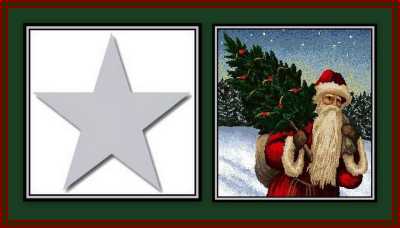
Following
the plays, we went to the
dining hall where the
dinner ladies had
decorated the tables with
Christmas-y paper
along with plates of
cakes and bowls of jelly.
I am sure that we feasted
well. And who
wouldn’t when
presented with mounds of
jelly and lots of cakes!
One thing I remember well
was that Johnny kept
referring to the jelly as
jello. We told him
that it was called jelly,
but he did not seem to
learn or care and
continued to talk about jello,
which he seemed to
like as much as we did.
Since Miss Davis had told
us to make Johnny feel
welcome, we allowed him
to continue on his merry
way.

Click on
the pictures above to
listen to music
| Once the
feast was over, it was
time for the visit of
Father Christmas. I was
most disappointed as I
wanted to meet him while
wearing my costume from
the play, but Miss Davis
said that it would not be
good form, so I
had to give up this idea.
Again Johnny seemed to
have his own name for
Father Christmas, as he
kept calling him Santa
Claus. Although he
was allowed to call
jelly, jello, he
was told, in no uncertain
terms, that the jolly
old gent was called
Father Christmas and not Santa
Claus! I don’t
think Johnny mentioned
him again. We
said good-bye to Johnny
on the last day of
school. He would be
returning to America on
New Year’s Day. He
wrote to the class once
via Miss Davis soon after
he returned home. She
read his letter to us
twice and when she had
finished, she said that
each of us should write a
short letter to him in
reply. About a week
later, Miss Davis
collected our meagre few
lines and put them into a
large manila envelope and
sent it off to him.
Although we never heard
from Johnny again, he
left a lasting
impression, as you will
see.
|
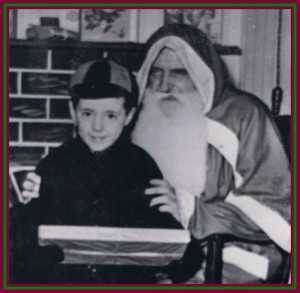 |
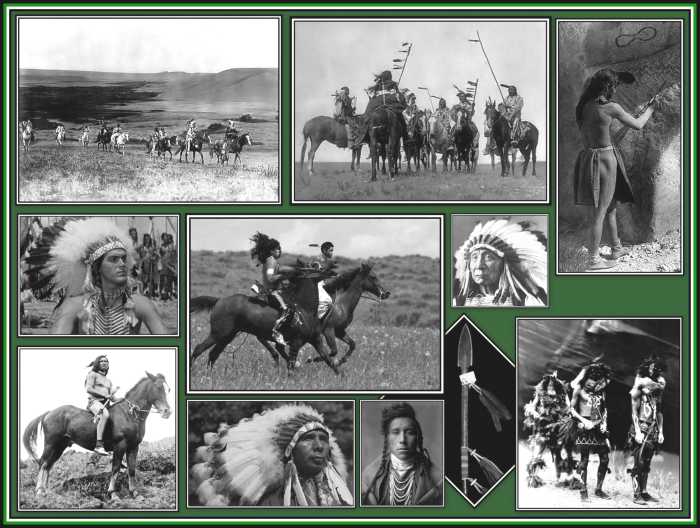
Click on
the pictures to hear
Native American music
It is
strange how an innocent
conversation can have a
profound and lasting
effect. As a result of a
misunderstanding of
something Johnny said in
answer to an innocent
question, my imagination took
off. Soon after he
joined the class, we
naturally asked him all
sorts of questions about
what he did, what he ate,
what he liked and which
types of films he liked.
We soon learned that his
likes and dislikes were
not that different to our
own. Most importantly, he
liked the same types as
films as we did. However,
he and I did disagree
over the relative merits
of cowboys and indians.
He preferred cowboys
while I preferred
indians. I liked seeing
indians ridding
full pelt, yelling
and screaming, and
sending arrows and lances
at the brutish people
opposing them. He liked
playing with Meccano, train
engines and cars, just as
we did. I remember asking
him about the games that
he and his friends
played. He mentioned some
that were similar to
those that we played.
When I asked him if he
played football or
cricket, he looked
puzzled, and then said
no. James said that they
did not play cricket in
America, but they played
baseball instead.
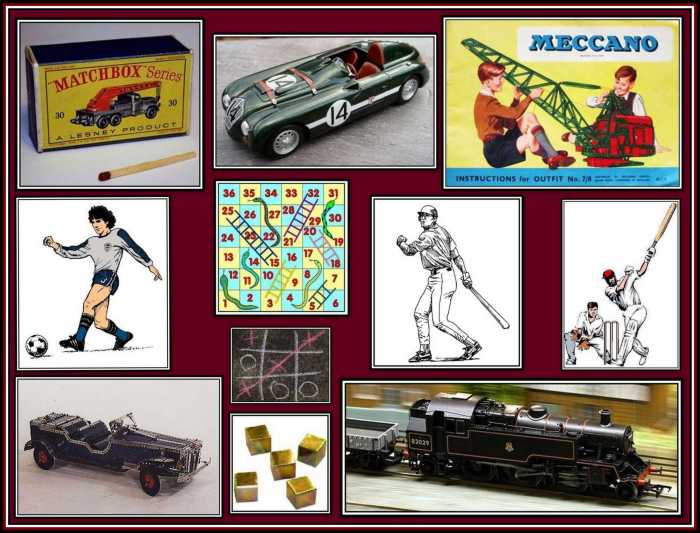
Baseball,
now what was that? I had
never heard of it. When
asked what it was, Johnny
began to explain the game
and soon two things
became obvious to us:
one, that he liked the
game very much, and two,
that we had no idea what
he was talking about. I
was just about to tune
him out, when I heard
him mention the words
…… The
Braves ……. and
quite suddenly, a simple
misunderstanding of his
meaning caused my
imagination to run
rampant.
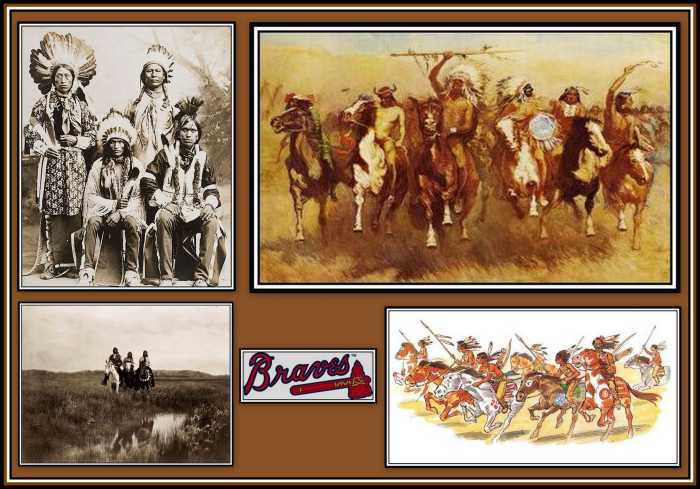
While lost
in my own thoughts and riding
across the plains along
with a wild raiding party,
Johnny continued to
ramble on about Baseball.
Braves! This is
what indian warriors were
called. Since my
imagination was working
overtime now, I was
convinced that he was
actually talking about real
indians while Johnny
was really talking about a
team! Since I was
very fond of indians, and
indeed had been given a
synthetic feather bonnet for
my last birthday, which I
held in high esteem, and
being a highly
imaginative child, I
suppose that my misunderstanding
was not too difficult
to understand. Anyway, I
soon convinced myself
that Baseball was played
by real indians riding
real horses! I
couldn’t believe
this game! It sounded
incredible! Once my
imagination took over, I
heard nothing else he
said and contented myself
with my own whimsical
thoughts!
We played Rounders,
of a sort, every
Thursday afternoon in the
playground during our Games
Period. Since we were
still very young, most of
us lacked good
co-ordination, however we
tried hard to hit and
catch the ball and run
between the bases. Miss
Davis organised us into
teams and we played for
about half an hour or so.
Johnny took to the game
and proved to be very
good at it. He kept
likening it to Baseball.
Naturally, after hearing
this, I took a greater
interest in it. Since I
liked indians, I
wanted to be as much like
them as possible and
thought that by playing
this game, it would help
me achieve this. Soon I
was imagining myself as a
Brave galloping
around the bases on my
horse and making for
home!
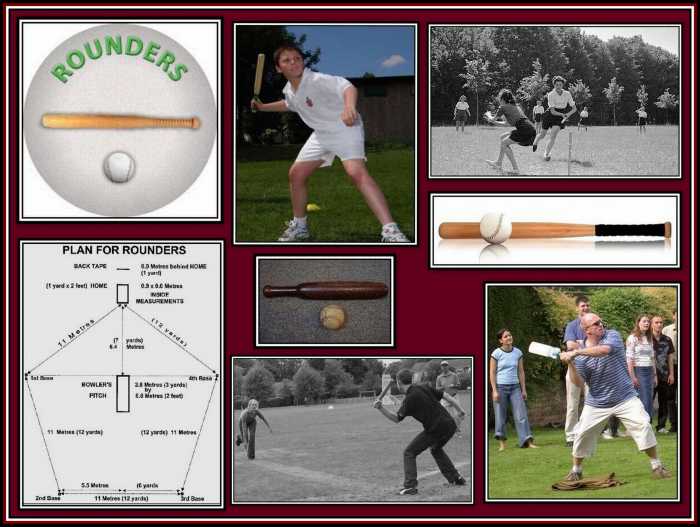
Once I was
a little older, I
remembered that Johnny
came from a place called
Milwaukee. It is a
strange name that I later
learned was an Indian
name and that the local
baseball team was known
as The Milwaukee
Braves!!! I have to
confess that I was more
than a little
disappointed to learn
that the team was not
made-up of real indians
after all, but then life
is filled with such
disappointments,
isn’t it?!
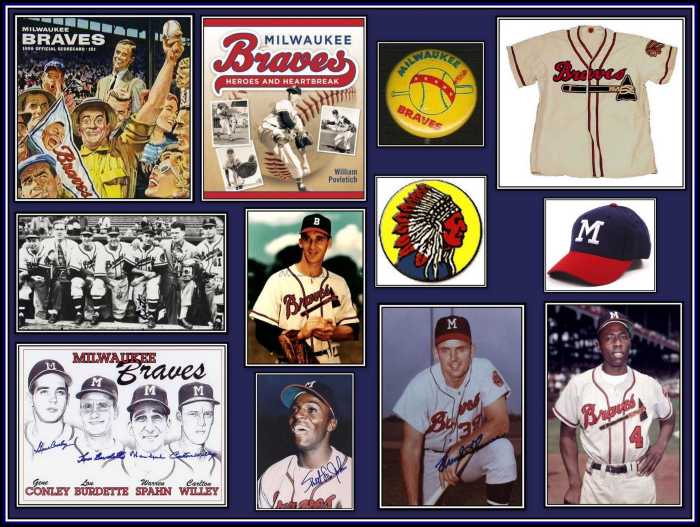
Click on a
Brave to
see film of the
sixth game of the 1958 World
Series between The
Milwaukee Braves and
The Yankees
However,
on a more positive note,
because of my meeting
Johnny and his talk of The
Braves and my own
imaginative memories of
what I thought they were,
I began to follow
their progress as a team.
I did this throughout my
school and college years
once I realised that the
scores of American
Baseball games appear in
certain of the better
newspapers in Britain.
Obviously there were a
sufficient number of
Americans living in
Britain to warrant this.
I found that following
the progress of The
Braves during these
years to be somewhat
demoralising. Sadly, they
were not very good during
this time and lost more
games than they won.
However, I stuck with
them.
In 1968, I
went to work in Toronto.
One of my main reasons
for going to live in
Canada at that time was
so I could travel and see
North America. During the
Easter holiday of 1969, I
went to New York and
Washington D.C. for the
first time. Once I got
back to Toronto, someone
asked me where I was
hoping to visit next. I
said that I wanted to go
to Milwaukee. Milwaukee???
Yes, I said,
Milwaukee!
Later that
summer, I went to
Milwaukee. I was filled
with excitement. I was
going to go and see The
Braves play!
Milwaukee was an
industrial town at the
time and the largest city
in the State of
Wisconsin. Since I did
not have a lot of money,
I went there by Greyhound
Bus, which I had boarded
in Chicago. The ride
to Milwaukee was not
especially interesting as
we followed a highway and
not Lake Michigan, as I
had hoped. I arrived in
Milwaukee late at night
and unfortunately my
first glimpse of the city
was not especially
impressive. Still, I was
there on a mission and
not to see the glories of
the town! I went to a
hotel and checked in.
The next morning I went
down to the front desk
and asked the desk
clerk where the
baseball stadium was. He
took out a small map and
circled the hotel site
and the ball park
on it. Who knew that the
stadium was not called
that, but a ball park?
He told me that I was
lucky as there was a day
game that afternoon
and would be able to get
a ticket easily, as the
team was not doing too
well that year and folks
weren’t going to the
game often! I asked
him how far away the
ball park was and he
told me that it was too
far to walk! I asked if
there was a bus that I
could get there. If he
was amused when I asked
if I could walk there, he
almost fell on the floor
when I mentioned a bus.
At that time, most
Americans never thought
to take a bus. Gasoline
was cheap and it was the
age of huge automobiles.
Why would they want to take
a bus?!!!
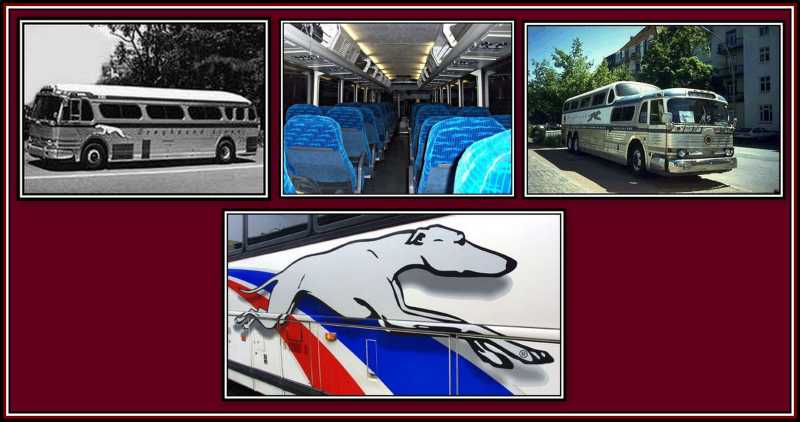
Click on
the collage for music
Eventually
I arrived at the ball
park! I could not
wait to get my ticket. As
I walked towards the
park, I noticed an
advertisement on the
wall. It announced that The
Brewers would be home
to the Chicago Cubs that
afternoon. The
Brewers? Who were The
Brewers? Where were The
Braves? My heart sank
when someone told me,
once they stopped
laughing, that The
Braves had moved!
Moved? How could a team
move? Players move!
Managers move! But teams?
I could not believe this.
The West Ham Football
Club would always, please
God, remain in East
London. Liverpool F.C.
will always be in
Liverpool, and so on. It
seems that this is not
the case in the United
States. I later learned
that teams can be sold
and that new owners
can take them to another
city. And it would seem
that several years
earlier, The Milwaukee
Braves picked up
sticks and moved south,
to Atlanta, in Georgia,
to be exact, and in doing
so, were now known as The
Atlanta Braves!!!
I
couldn’t believe
that I had been so stupid
and had not learned this
in Toronto. I was
embarrassed to say that I
had not told anyone why I
was going to Milwaukee.
Obviously, had I done so,
I would have known.
Amusingly, I maintained
silent on
this faux pas for
years, but once I got
over the
embarrassment of the
mistake, I began to tell
others about it and I
laughed, along with them,
at myself and my
stupidity!!!
Regardless
of whether The Braves were
in Milwaukee or Atlanta,
once I came to live in
the United States in
1980, I was able to
become a full-time fan!
Not just a fan, however!
My interest in Baseball
and in The
Braves
in particular verged
on the obsessional. Thanks
to the owner of the team
and also his ownership of
a television channel, now
being readily available
all over the country
thanks to cable
television outlets, I was
able to watch almost
every game each summer.
During the late 1980s and
early 1990s, the team
went through a Golden
Age and won the World
Series for the first
time since they had been
in Boston. It seemed that
before being The
Milwaukee Braves,
they were The Boston
Braves!!! Imagine
that!
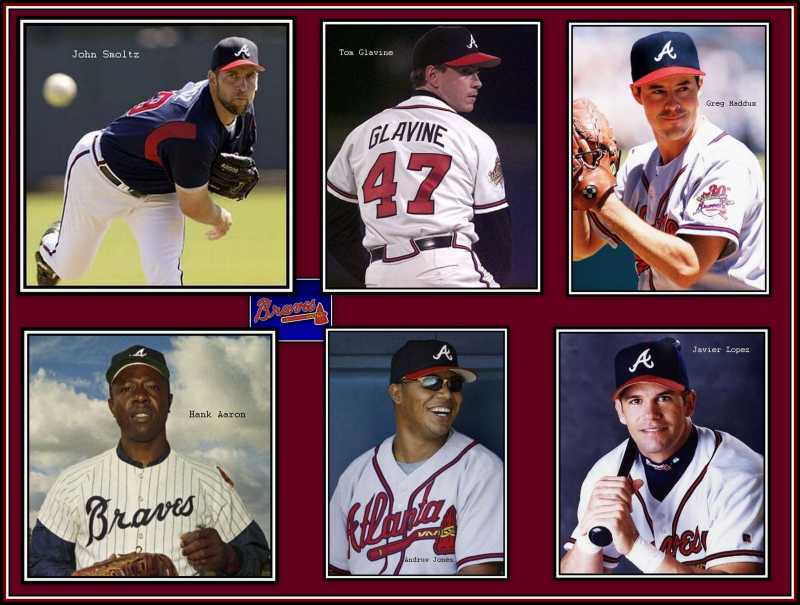
Click on a
Brave to hear music
FINAL
NOTE
Anway, I
thank Johnny for making
my misunderstanding possible,
for without it, I might
never have discovered The
Braves and Baseball
and spent many happy
hours watching games, and
later listening to them
on the radio, which has
proved to be a far more
entertaining way to
follow the games. Radio
is a wonderful medium, as
it allows one’s
imagination to run
rampant! Thanks to
radio, I can once again
imagine that each Brave
is not just a player,
but is in fact a Brave
astride a horse and
racing around the bases
heading for home!
I
have written a series of
fantastic
tales about the
meetings of The
Braves, as real
indians, with other teams
as seen according to
their names under the
title, The Atlanta
Scrolls.
Should you have an
interest in reading them,
please contact
me
via the website.
One final
point regarding Johnny,
or rather, Johnny’s
pen: it proved not to be
too well made and quickly
fell to pieces.
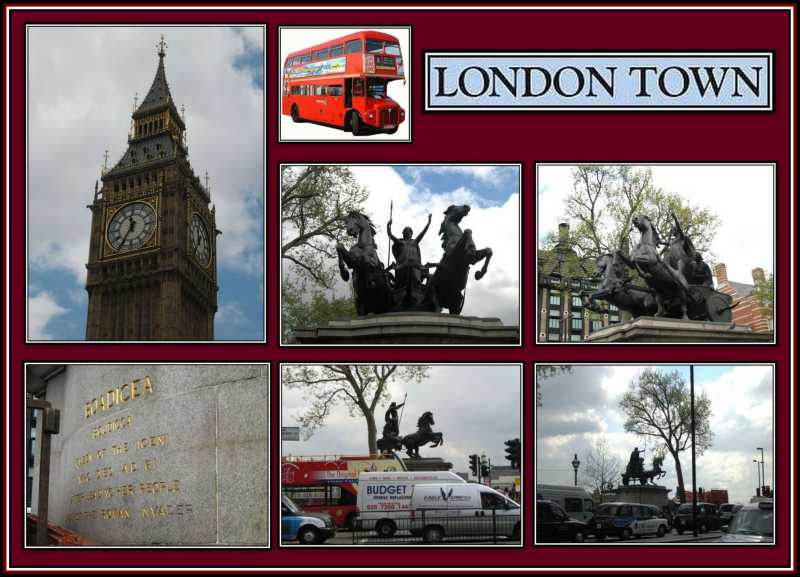
Click on
the pictures for songs
and music associated with
London
|